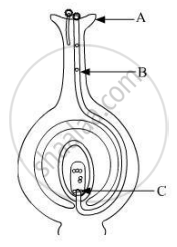Advertisements
Advertisements
Question
Mention the changes a flower undergoes after fertilisation.
Solution
- The outer layers of the ovule become impervious and hard and function as a seed coat. An ovule with an embryo inside is called a seed.
- The ovary enlarges and ripens to become a fruit. Other floral parts such as sepals, petals, stamens, styles, and stigma may fall off. However, in some cases, they remain persistent in the fruit.
APPEARS IN
RELATED QUESTIONS
A student was asked to observe and identify the various parts of an embryo of a red kidney bean seed. He identified the parts and listed them as under:
I. Tegmen
II. Testa
III. Cotyledon
IV. Radicle
V. Plumule
The correctly identified parts among these are
(A) I, II and III
(B) II, III and IV
(C) III, IV and V
(D) I, III, IV and V
Name the parts A, B and C shown in the diagram and write their functions.

What is the name of female organ of a flower (other than carpel)?
Which of the following statements are true for sexual reproduction in flowering plants?
(i) it requires two types of gametes
(ii) fertilisation is a compulsory event
(iii) it always results in the formation of zygote
(iv) offsprings formed are clones
(a) (i) and (iv)
(b) (i), (ii) and (iv)
(c) (i), (ii) and (iii)
(d) (ii), (iii) and (iv)
In a bisexual flower, inspite of the young stamens being removed artificially, the flower produces fruit. Explain.
Fill in the blank by selecting suitable word:
A flower bearing only male or female parts is known as __________ flower.
Fill in the blanks:
A stamen consists of ______ and ________.
Give one example each of unisexual and bisexual flowers. Differentiate between the two types of pollination that occur in flowers. What happens when a pollen lands on a suitable stigma? Write about the events that occur till the seed formation in the ovary.
What is cleistogamy? Write one advantage and one disadvantage of it, to the plant.
Identify the parts A, B, C, and D?

